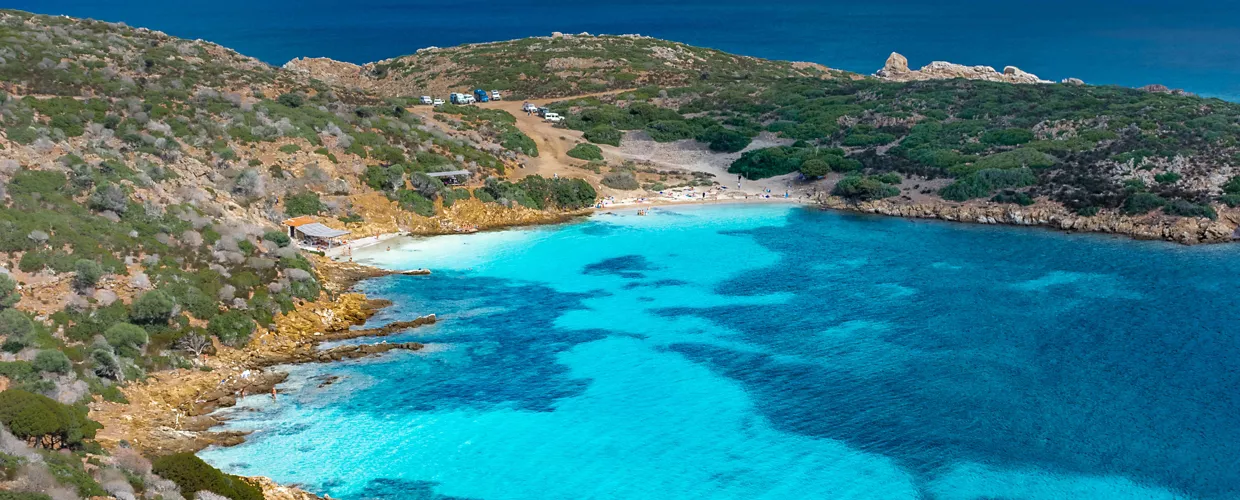This content was automatically translated. View the original text.

Overview
The island of Asinara: the long history of a magical place
The Romans called it the Island of Hercules before it became a land of contention between the Maritime Republics of Pisa and Genoa, then domain of the Savoy, a place of confinement, leper house and prison.
The island of Asinara has had a long and troubled history, but almost a century of isolation has made it a still unspoilt natural paradise.
Today, a protected marine area to be explored on foot, by bicycle or boat, discovering the wilder and rockier west coast and shallow shores and sandy seabed of the east.
Donkey Island
According to legend, Hercules grasped the end of Sardinia with his mighty hand, tearing it from the mainland, hence the name, Herculis Insula. Later called Sinuaria for the wealth of gulfs and inlets on its 110 km of coast. Asinara is perhaps a mispronunciation of the Latin or perhaps it refers to the white donkeys that have lived there since time immemorial and still live free on the island.
A story that begins in the Neolithic
In the Campu Perdu area, in the north of the island is a domus de janas, evidence that these places were inhabited since the Neolithic period. A few wrecks found in the sea remain from Roman times. One is still visible a few metres from the jetty in Cala Reale.
Over time, the island had to deal with Arab raids, later skirmishes between Pisa and Genoa for supremacy in the Mediterranean. It was the Ligurian Malaspina who built the Castellaccio here, which dominates the entire gulf from above. The pirate Barbarossa landed nearby to hide between robberies.
In 1885, Asinara became a penal colony and the island's inhabitants had to leave. Many of them founded Stintino, then called Cala Savoia. Since then, the island remained inaccessible for over a century. Only since 1998, when the maximum security prison was closed, has it reopened to visitors.
Asinara's most beautiful beaches
Being a protected reserve, not all beaches on the island are accessible. These can only be admired from afar, Cala Sant'Andrea and Cala d'Arena. Caretta caretta turtles lay their eggs here. Cala Sabina can be reached via ancient mule track. It is 30 minutes from Cala d’Oliva.
Near Cala d’Oliva are Cala Murichessa and Cala Giardino. Don't miss Cala di Sgombro at the narrowest point on the island: steep cliff with rough sea on one side, sandy seabed with a calm sea on the other.
On foot, by bike, off-road... or swimming!
The best way to immerse yourself in the Asinara National Park wilderness is to walk around it. But watch out for the sun: there is hardly any shade. Also bring sufficient water because there are only two cafes on the island.
In Cala Reale you can hire electric bikes and cars, sailboats and canoes. Or book an off-road tour accompanied by Geomarine Environmental Guides. This is the only way to visit certain areas of the island like Cala Trabuccato and Punta Scorno.
A visit to Asinara cannot be complete without a dip in its crystal-clear waters. Not only for a refreshing swim in the water in shades of blue to green, but also to observe the wonderful seabed populated by countless creatures: a snorkelling paradise. During a boat trip it is easy to spot dolphins, even sea turtles.
Not only nature: what else to visit
Although nature is the dominant feature, there are many human traces to be discovered around the island. In addition to the Neolithic Campu Perdu domus de janas and the Castellaccio ruins, several watchtowers built in the 16th century can be found along the coast.
The Ossuary, built to house the remains of thousands of Austro-Hungarian prisoners during the WWI, dates back to 1936.
In Cala Reale, there is the Royal Palace, former summer residence of the Savoy family.
In Fornelli, you can visit the old prison.
Asinara, 07046 Porto Torres SS, Italia